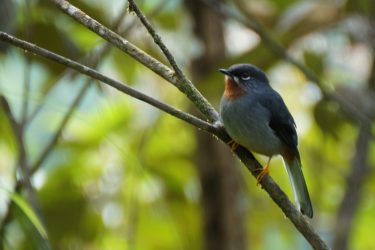In this series of blogs, Ed Drewitt freelance naturalist, broadcaster and wildlife detective highlights a different St Lucia bird each week. In this last edition the Grey Kingbird
By: Ed Drewitt

When I stay at Anse Chastanet I love listening to the dawn chorus, when everything begins to sing in the half light as I’m waking up. The first birds to sing are the grey kingbirds, followed by the zenaida doves. They are up at first light to protect their territory and nest by making their chattering calls from an exposed high perch. It’s a sound that travels with me across St Lucia as the kingbirds love perching by roadsides and open spaces. Wherever you are travelling in St Lucia look out for grey kingbirds perched on the electricity, fences and phoneline cables, often in pairs. They like to be in open, dry areas often close to the coast and near water and will obviously fly out from their perch in a circle to catch prey.

Grey kingbirds are large flycatchers, the size of an American Robin or European Blackbird and both sexes look similar. They are a type of tyrant-flycatcher, a family of birds that is one of the largest and most diverse in the Western Hemisphere, with at least 429 species. When I am in Trinidad or South America I feel joy at seeing some of their relatives such as the Great Kiskadee and Boat-billed Kiskadee.

When perched up above you on wires or branches you just see their white breast and broad beak. Their upper body is grey and they have a black band running through their eyes like a mask. If you watch one for long enough you may notice it has a bright and dazzling yellow-orange or even red patch of feathers on the top of its head, usually hidden between its grey head feathers and larger in the males. Like other flycatchers, their beak is broad at the base and provides an ideal catching device that snaps shut as soon as it engulfs a moth, beetle or dragonfly. They will eat small lizards too and very rarely hummingbirds, thought to be mistaken for large insects. If you are driving somewhere early in the morning on St Lucia you will often see them catching moths and other insects around streets lamps before they switch off.

Nesting begins in March and carries on through to July; watch out for them collecting nest material or carrying insects in their beaks for young during this period. During courtship you may see grey kingbirds noisily spiralling up in the air together and snapping their beaks. If a mammal predator such as a cat or mongoose is close to the nest the pair will defend it voraciously, making themselves look bigger by opening their wings, and physically swooping down to the animal striking it with their feet and beak.

To hear the sounds made by grey kingbirds and to listen for them at first light, visit here.
Ed Drewitt is a freelance naturalist, broadcaster and wildlife detective
Learn More About Bird Watching at Anse Chastanet here

Anse Chastanet Resort

